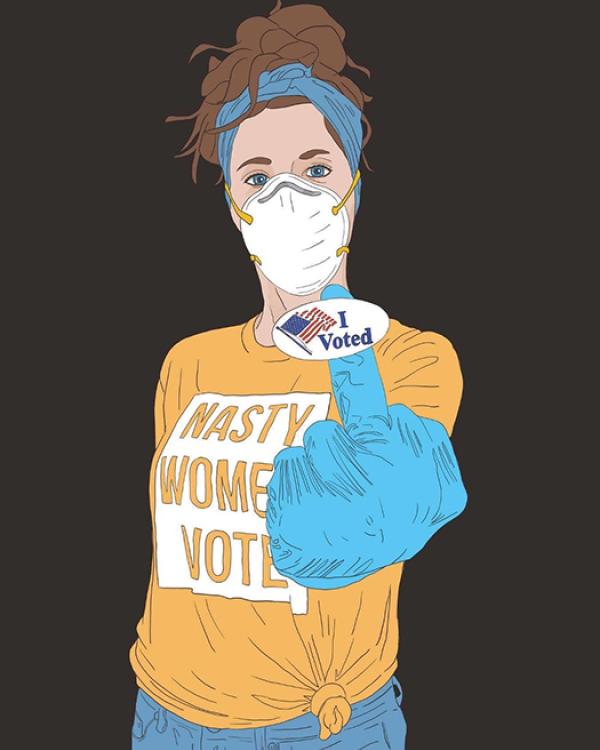
The weeks of quarantine all seem to blend together; Mondays are easily confused with Tuesdays and the Friday Fish Fry is nearly the only weekly mile marker I have. Most recently, I’ve been quite reflective of my journey across the country in a need to be near family as this all unfolds. I am grateful to have the privilege to have made such a rapid journey. The road trip itself took place in March, but as my high school friend who accompanied me from Colorado to Wisconsin would point out, it was the first time she had heard me sing. Naturally I shrugged, but music has become such a necessary component of maintaining normalcy that maybe our overnight journey was just a foreshadowing of my Spotify account becoming the only spending I cared to conduct.
Jump past my two weeks in quarantine at my sister’s apartment—another moment I recognize to be entirely privileged—I returned to where I would be heading the rest of this pandemic out, and where I write you from: home. I will admit, returning to a childhood home as an adult for an undetermined amount of time with your adult sibling and adult parents is hard, but also, beautiful. We’re finishing up week four of the spring quarter and much like all the quarters, I’m still confused how we got here so fast.
The good
I feel fortunate to have had a positive disposition moving through all that unfolds. Some days bring me to tears, but others make me laugh. Moving to an online teaching platform for my high school kids at SBHS has presented a unique set of challenges, but it has also left me to my creative devices to create content-filled videos that remain engaging and relevant. Most recently, I created a stop-go Lego animation video for my students, which addressed gendered language and adjective assignment. The video, which took nearly four hours to conduct, three hours to edit, and only a few moments to view, was a labor of love from my sister and I to the high school students living their own pandemic realities.
I’m not sure that I have nearly as cautious a view about online teaching others, in fact I find it a great opportunity for continued learning. What better time is there to reengage with movie-making hobbies than the social need for asynchronous videos which support student learning? Yet, I wonder how will education look moving forward? In my conversation with teachers at this moment, the idea of recording lectures for future absences is exciting, a new tool they are eager to implement when the return to the classroom occurs. But when and how does the return to normal look?
Aside from such news skills, I have stretched my competitive legs and begun winning family board games. I will admit that my affinity for deductive reasoning and success in Clue is quickly lost when we transition to any game of hand-eye coordination; I will hand that success off to my non-competitive sister.
The bad
In the last two weeks, Wisconsin has been in the national spotlight for its call for eligible Wisconsinites to still head to the polls and vote. Excuse me, but what? A gubernatorial executive order postponed state elections, but the Wisconsin Supreme Court quickly overturned it. I’m sorry, what? Thousands of absentee ballots sat idle and undelivered, for those fortunate enough to have their ballot postmarks were late. And yet, Wisconsin still showed up to vote. In the midst of the pandemic, the same question that has been historically asked: “What would you do for the right to vote?” was thrown onto Wisconsin voters. Polling places run on volunteers, and city centers such as Milwaukee and Madison, did not have enough volunteers to staff the necessary polling places. Do you know what else is different about Milwaukee and Madison? They vote blue, almost always. The Wisconsin legislature is red. Clearly, making purple in this case wasn’t an option. And yet, people showed up, they voted, and Wisconsin has sense moved out of the national spotlight. But even in the face of a pandemic, voter suppression is alive and well.
Mary Franitza is a first year MA/PhD student in the Department of Education. She started her quarantine with a frantic two-day road trip from Santa Barbara to a small coastal corner of Wisconsin. Mary is spending her time social distancing with her adult family members, two parents (sixty-four), and sister (thirty) and her just as adult cats, Dodger (soon to be ten) and Socrates (probably thirteen). Whilst at home, Mary is still responsible for work with high school seniors at Santa Barbara High School and tending to her course load and research. Mary is approaching quarantine with a critical feminist lens as she watches the pandemic unfold in her hometown.